
Chet Atkins
 Any intelligent conversation, magazine article, book, review, term paper, website, or personal opinion about guitar playing or the evolution of the
instrument or music styles in the past century would have to have at the top of it’s shortest list of contributors the name of Chet Atkins.
There is simply no one else like him. Mr. Guitar, don’t you know. The Father of Fingerstyle Guitar. No single style category can hold him.
Chet is inventor, artist, and technician all rolled into one.
Any intelligent conversation, magazine article, book, review, term paper, website, or personal opinion about guitar playing or the evolution of the
instrument or music styles in the past century would have to have at the top of it’s shortest list of contributors the name of Chet Atkins.
There is simply no one else like him. Mr. Guitar, don’t you know. The Father of Fingerstyle Guitar. No single style category can hold him.
Chet is inventor, artist, and technician all rolled into one.
Kirk’s association with Chet goes back several years before he actually built him a guitar. They had a dear friend in common, Lenny Breau. Chet had befriended and recorded with Lenny and Kirk had built Lenny a beautiful birdseye maple seven-string guitar. Chet played Lenny’s new guitar and liked it. When Lenny died in 1984, Kirk and Chet became acquainted through their mutual good friend, John Knowles.
A few years later, Kirk finished developing his classical electric guitar. It had been a long process of refining and building prototypes, but the final product was worthy of even Chet Atkins’ approval. Chet ordered one and the day he got his new Sand Classical Electric, he "ran it up to Gibson" and arranged to have them start building guitars of this design and include them in their Chet Atkins line of Gibson guitars.
Gibson contacted Kirk and he provided them with a "come-apart" guitar just like Chet’s, and all the technical assistance they needed to build the "Studio Classic".
Kirk, being a perfectionist, has fine-tuned his design over the years, giving it a newer shape. And although he offers customers several different body depth options, wood options, cosmetic choices, etc., every guitar in the classical electric line of Sand Guitars is a direct descendent of that guitar he made for Chet.
Click here for text and pictures from Russ Cochran's book "Chet Atkins Me and My Guitars" (used by permisson).
Besides being an accomplished builder, Kirk Sand is an innovator. He has designed and manufactured a nylon string guitar which has a beautiful sound, is fun to play, very futuristic and is utilized by some of the very best players. I predict he will be in the forefront of design and meeting the needs of quitarists for years to come.
That's the wonderful thing about the guitar. Each generation has its innovators who carry the legacy further and our combined knowledge grows and gets passed on as the guitar's secrets are revealed, one by one. I am not the greatest guitarist, but I am very proud of the part I've played in its history. And I know, as the torch is passed, our beloved instrument is in good hands with players like Jerry Reed, Tommy Emmanuel, Richard Smith, Jim Nichols, Doyle Dykes, and many others who will carry on the tradition which started long before me and which will hopefully continue long after we are all forgotten. *
Chet Atkins, C.G.P.
* It is interesting to note that all the guitarists mentioned by Chet in the above quote play Sand guitars.
Chet Atkins
 Any intelligent conversation, magazine article, book, review, term paper, website, or personal opinion about guitar playing or the evolution of the
instrument or music styles in the past century would have to have at the top of it’s shortest list of contributors the name of Chet Atkins.
There is simply no one else like him. Mr. Guitar, don’t you know. The Father of Fingerstyle Guitar. No single style category can hold him.
Chet is inventor, artist, and technician all rolled into one.
Any intelligent conversation, magazine article, book, review, term paper, website, or personal opinion about guitar playing or the evolution of the
instrument or music styles in the past century would have to have at the top of it’s shortest list of contributors the name of Chet Atkins.
There is simply no one else like him. Mr. Guitar, don’t you know. The Father of Fingerstyle Guitar. No single style category can hold him.
Chet is inventor, artist, and technician all rolled into one.
Kirk’s association with Chet goes back several years before he actually built him a guitar. They had a dear friend in common, Lenny Breau. Chet had befriended and recorded with Lenny and Kirk had built Lenny a beautiful birdseye maple seven-string guitar. Chet played Lenny’s new guitar and liked it. When Lenny died in 1984, Kirk and Chet became acquainted through their mutual good friend, John Knowles.
A few years later, Kirk finished developing his classical electric guitar. It had been a long process of refining and building prototypes, but the final product was worthy of even Chet Atkins’ approval. Chet ordered one and the day he got his new Sand Classical Electric, he "ran it up to Gibson" and arranged to have them start building guitars of this design and include them in their Chet Atkins line of Gibson guitars.
Gibson contacted Kirk and he provided them with a "come-apart" guitar just like Chet’s, and all the technical assistance they needed to build the "Studio Classic".
Kirk, being a perfectionist, has fine-tuned his design over the years, giving it a newer shape. And although he offers customers several different body depth options, wood options, cosmetic choices, etc., every guitar in the classical electric line of Sand Guitars is a direct descendent of that guitar he made for Chet.
Click here for text and pictures from Russ Cochran's book "Chet Atkins Me and My Guitars" (used by permisson).
Besides being an accomplished builder, Kirk Sand is an innovator. He has designed and manufactured a nylon string guitar which has a beautiful sound, is fun to play, very futuristic and is utilized by some of the very best players. I predict he will be in the forefront of design and meeting the needs of quitarists for years to come.
That's the wonderful thing about the guitar. Each generation has its innovators who carry the legacy further and our combined knowledge grows and gets passed on as the guitar's secrets are revealed, one by one. I am not the greatest guitarist, but I am very proud of the part I've played in its history. And I know, as the torch is passed, our beloved instrument is in good hands with players like Jerry Reed, Tommy Emmanuel, Richard Smith, Jim Nichols, Doyle Dykes, and many others who will carry on the tradition which started long before me and which will hopefully continue long after we are all forgotten. *
Chet Atkins, C.G.P.
* It is interesting to note that all the guitarists mentioned by Chet in the above quote play Sand guitars.
Excerpt from "Chet Atkins Me and My Guitars"
"The next member of the CA line of Gibson amplified nylon string guitars was the Studio Classic. This semi-acoustic guitar came from a design by California guitar builder Kirk Sand. He designed a thin acoustic guitar with a standard braced classic top. He amplified it with a Ray Butts preamp and a Gibson CE pickup. I liked it so well I started playing it. To avoid any problems with Gibson, I had a Gibson decal put on the headstock of it. Then I persuaded Gibson to make a deal with Kirk and they started making the guitar using his design."
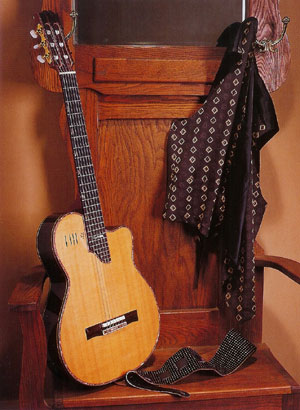

Posed on an antique oak hall tree in the lobby of Chet's office, these two Kirk Sand guitars served as the first prototype design for the Gibson Studio Classic. The two guitars are almost identical one has a thicker body.
Lenny Breau
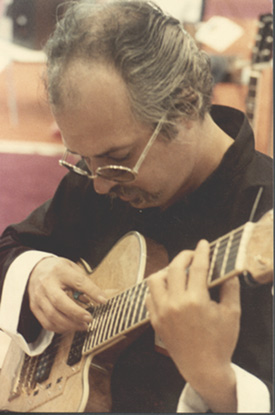 Lenny Breau was truly a guitar player’s guitar player. This Maine-born jazz artist had very few peers but even they,
along with his fans, were continually fascinated and inspired by the completely original and innovative workings of his musical mind. Lenny
invented things to do on the guitar that no player had done. He recorded several solo albums. He naturally caught the attention and respect of
the great Chet Atkins who recorded an album with Lenny and became his friend.
Lenny Breau was truly a guitar player’s guitar player. This Maine-born jazz artist had very few peers but even they,
along with his fans, were continually fascinated and inspired by the completely original and innovative workings of his musical mind. Lenny
invented things to do on the guitar that no player had done. He recorded several solo albums. He naturally caught the attention and respect of
the great Chet Atkins who recorded an album with Lenny and became his friend.
In 1982, Kirk built Lenny a solid body seven string jazz guitar with a high A string. It was a very special guitar and is the most "custom" guitar he has ever made. It had a birdseye maple top and faceplate on the headstock, humbucking pickups, a hand sculpted brass tailpiece, and a set of roller controls that Lenny could access without moving his right hand while he was playing. Lenny was thrilled with the new guitar!
The untimely passing of Lenny Breau in 1984 has not served to diminish his effect on the guitar-playing world. This singular and purely gifted man continues to challenge and inspire us.
Doyle Dykes
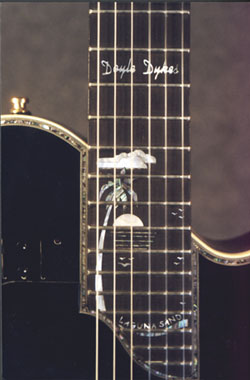 We have watched Doyle’s congregation of guitar aficionados grow in leaps and bounds in these past years and are so proud
and happy to have him as a friend and enthusiastic endorser of Kirk’s Classical Electric guitars. Each time Doyle has come to do a workshop/concert
for Sand Guitars the room has been filled to overflowing and every person that attended left feeling spiritually and musically fed as well as motivated to go home and practice.
He is truly an inspiration.
We have watched Doyle’s congregation of guitar aficionados grow in leaps and bounds in these past years and are so proud
and happy to have him as a friend and enthusiastic endorser of Kirk’s Classical Electric guitars. Each time Doyle has come to do a workshop/concert
for Sand Guitars the room has been filled to overflowing and every person that attended left feeling spiritually and musically fed as well as motivated to go home and practice.
He is truly an inspiration.
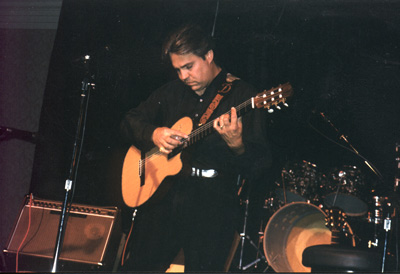
Doyle and Kirk have collaborated on a Doyle Dykes model Sand Classical Electric guitar. It is a slightly deeper mahogany model with an inlay on the fretboard similar to the Sand Guitar logo design with a palm tree and sun setting over the water. The most recent one Kirk made for Doyle has a black top with abalone trim.
Catch Doyle Dykes on his latest CD, "Guitar 2000" or at a church or Taylor clinic near you. His travel schedule takes him to every state in America.
Kevin Eubanks
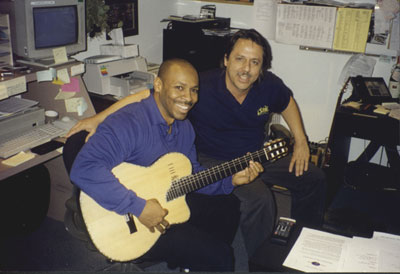 Kevin Eubanks is that wonderful jazzman/band leader for Jay Leno on the Tonight Show. When you meet him you would never
know that this quiet, smiling, unassuming guy is such a guitar monster. He has arranged for and accompanied probably every big
name in the music business during his reign on late night
television.
Kevin Eubanks is that wonderful jazzman/band leader for Jay Leno on the Tonight Show. When you meet him you would never
know that this quiet, smiling, unassuming guy is such a guitar monster. He has arranged for and accompanied probably every big
name in the music business during his reign on late night
television.
Two years ago, Kirk built Kevin a three-inch deep rosewood classical electric guitar with the widest neck he’s ever made. Kevin uses it on the show whenever the music calls for that nylon string sound. Watch for it!
Jose Feliciano
 Since the 1970’s, Jose Feliciano has been a huge presence in the music world. His playing style is completely unique in that it blends percussive flamenco with
classical techniques and the speed and improvisational skills of a jazz player. And all of this is going on while he’s singing! What a voice! If one of his songs comes
on the radio you know who it is by the second word. Nobody else sounds like that.
Since the 1970’s, Jose Feliciano has been a huge presence in the music world. His playing style is completely unique in that it blends percussive flamenco with
classical techniques and the speed and improvisational skills of a jazz player. And all of this is going on while he’s singing! What a voice! If one of his songs comes
on the radio you know who it is by the second word. Nobody else sounds like that.
Jose, born in Puerto Rico, is the youngest of eleven children and is the only member of the family to become a musician and famous. Even as a child of six, he would just sit around all day playing his guitar and singing.
Jose’s "Light My Fire" album was number one in the United States and he has had many other hits as well. His own Christmas composition, "Feliz Navidad," is now a holiday standard. He has turned out English and Spanish albums by the score and has been nominated Acoustic Guitar Player of the Year more times than he has wall space to celebrate with.
When Kirk met Jose, the talk naturally turned to guitars. Jose, primarily a nylon string player, expressed his interest
in a special guitar. He wanted "more" out of his instrument. More sound, a faster neck, bigger bass. The guitar design that grew out of that conversation was to become the Jose’ Feliciano
model: a nylon string guitar with a jumbo body, a thin top braced so that the bass really boomed, and a thin profile neck. The finished guitar was exactly as described and Kirk had himself
his first endorser. Jose was so happy with his Sand Guitar that he played it almost exclusively. Eventually, Kirk made him another guitar, this time with a cutaway for more comfortable access to the higher frets. Jose also owns a Sand classical electric.
Kirk and Jose had become very good friends, spending time together both at the Guitar Shoppe and at Jose’s home when he lived in Southern California. The Feliciano family moved to Connecticut about ten years ago, but we still enjoy very much turning on the television and finding Jose playing his Sand Guitar.
John Knowles

Kirk and John became close friends in 1978 when they shared a booth space at a NAMM show. John was there with Soundhole Records and Kirk was there showing his early guitars. John had been working with Chet to transcribe a book of his songs and they had done some recording together. John also did some guitar arranging for him and even co-wrote some tunes with him.
Because of the natural mutual admiration Kirk and John hold for one another, John has been a very important player in the development of Sand Guitars. When Kirk first ventured to build a classical electric guitar, it was the input from his friend, John Knowles, that consistently contributed to refining and directing the design. Kirk would collaborate with John about the sound, especially. Each new prototype reflected his input and critique from the previous attempt and on and on until Kirk finally came up with the present design and it received the John Knowles nod of approval. It was five years in the developmental stages.
We will be eternally grateful to John for making that connection between Chet Atkins and Sand Guitars.
John Knowles has played the guitar all his life. He earned a Ph.D. in physics, but left his job with Texas Instruments to move to Nashville and do what he really loved: music. Today, John is one of the directors of the Country Music Foundation in Nashville, Tennessee. He continues to write, arrange, and play the most beautiful music you’ve ever heard and is one of the main attractions at the CAAS convention, as well as many other guitar camps and workshops all over the United States.
Jim Nichols
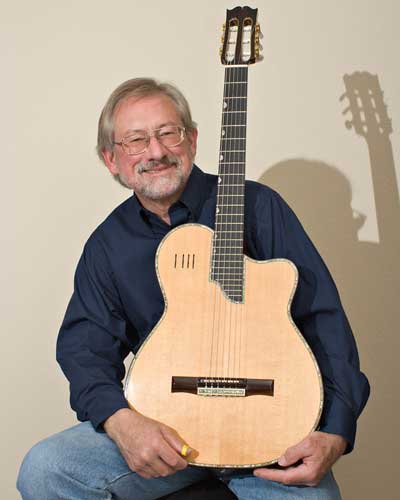
Jim Nichols has an unusual approach to the guitar--he uses a thumbpick and fingers to play everything from Chet Atkins style to modern jazz . His impressive credentials
include appearances on tv, radio, concert halls and clubs including Carnegie Hall and the Tonight Show. He has played and/or recorded with Joe Pass, Kenny Rankin, Buddy Montgomery, Art Pepper, Van Morrison, Chet Atkins , Mark Murphy and Hubert Laws, to name a few.
Jim has appeared on TV, including the Tonight Show and performed at many venues, including Carnigie Hall. He has played on many records, jingles, radio and club dates, and has taught guitar for many years. He served as master instructor for the Jamey Aebersold Jazz Workshops, Stanford Jazz Workshops and held clinics on both jazz and Atkins style for the Chet Atkins Appreciation Society national convention in Nashville, the CAP Guitar festival in Bordeaux, France and the Atkins-Dadi Guitar Convention in Issoudun , France. Jim and his vocalist wife Morning have performed at festivals and clubs in the U.S., England, Germany, Italy, Finland, and France, including the Olympia Theater in Paris. Jim was featured at the 18th annual Django Reinhardt Festival in trio with Martin Taylor and Romane, to great reviews.
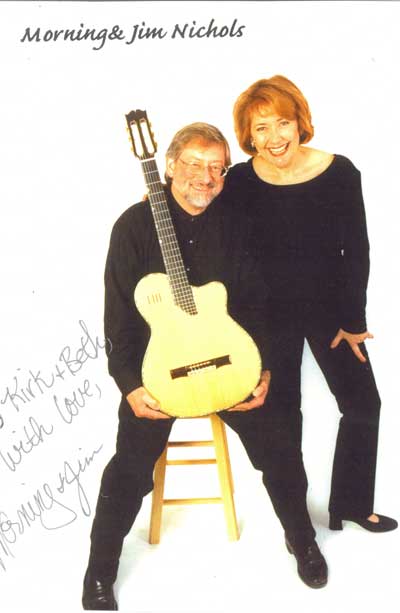
In addition to an acoustic duo CD with Australian guitarist,Tommy Emmanuel and a duo CD with fingerstyle guitarist, Richard Smith, Jim and Morning, have 5 CDs to their credit. Jim's solo CD, Jazz and Country was chosen by Guitar Player as a "pick of the year" for '96 and in 2001, he was featured in Fingerstyle Guitar Magazine and Acoustic Guitar Magazine . His most recent project is called Lodges, for Menus and Music and a new CD of solo acoustic lullabies is in the works for the same company.
Jerry Reed
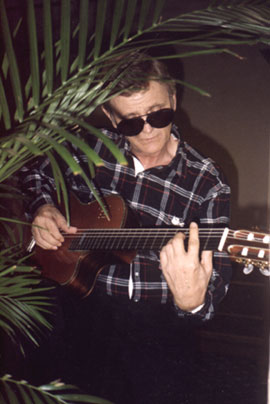 Whether you know Jerry Reed from the movies or from his long musical career, it doesn't really matter. The truth is, once you've seen Jerry, you'll never forget him.
He is an A-number one, real McCoy, 100 proof, bonafide, authentic, dyed-in-the-wool character of millennial proportions. So, it's not a surprise that his music is, too.
Whether you know Jerry Reed from the movies or from his long musical career, it doesn't really matter. The truth is, once you've seen Jerry, you'll never forget him.
He is an A-number one, real McCoy, 100 proof, bonafide, authentic, dyed-in-the-wool character of millennial proportions. So, it's not a surprise that his music is, too.
Jerry's songs are so packed with clever smart stuff that they have attracted the attention of the greatest fingerstyle players in the world, especially Chet Atkins.
Chet LOVES Jerry's songs and has recorded almost as many of them as Jerry has. They are longtime friends and have frequently performed and recorded together.
Although Jerry describes himself as "a guitar thinker, not a guitar player," we will have to beg to differ here. Jerry's fingerstyle playing is so true to the music that he writes that it's difficult to discern which came first. (Does he play like that because he writes like that? Or does he write like that because he plays like that? Impossible to tell.) Don't waste your time worrying about it.
Ask any fingerstyle player what song they’re currently working to master and it's a pretty safe bet they're going to mention some Jerry Reed song. Some fingerstylists major in Reedology! His music is like an addiction! And he keeps writing more! His unbridled imagination staggers and stupefies peers and addicts alike. Kirk met Jerry at a Chet Atkins Appreciation Society convention about 6 years ago. Jerry was there to pay tribute to Chet and to be honored himself by his friend, Mister Guitar. The show was in full swing when Jerry strolled into the exhibit room announcing that he was looking for "that Kirk Sand booth." He had played Chet's Sand Guitar up at CGP headquarters and wanted to meet Kirk and hire him to build a guitar.
Kirk built Jerry a guitar very similar to the one he had made for Earl Klugh with rosewood back and three-inch bent sides. Jerry complained that his thumbpick would hit the top of his other guitars, so Kirk made the new guitar with more clearance between the strings and the soundboard. (I will never forget the Brazilian rosewood on that guitar.)
Richie Sambora
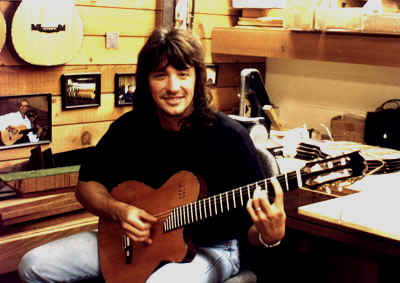 When Richie was in junior high school, he teamed up with his best friend, Jon Bon Jovi, and a bunch of pals and made a garage band that never stopped.
Bon Jovi, also called "The Band of the Eighties" has as its lead guitarist, Richie Sambora: rock and roll star, New Jersey native, husband to Heather Locklear
(yes, she's as gorgeous and nice in person as you could ever hope) and one heck of a screaming lead guitar player.
When Richie was in junior high school, he teamed up with his best friend, Jon Bon Jovi, and a bunch of pals and made a garage band that never stopped.
Bon Jovi, also called "The Band of the Eighties" has as its lead guitarist, Richie Sambora: rock and roll star, New Jersey native, husband to Heather Locklear
(yes, she's as gorgeous and nice in person as you could ever hope) and one heck of a screaming lead guitar player.
Richie has a home not too far from the Guitar Shoppe. He wandered in one day and struck up a conversation
and a friendship with Kirk. He fell in love with Kirk's classical electric guitars, but was leaving on a world wide tour in a few weeks, so there
was no way for Kirk to make him one before he left. Kirk loaned him one and Richie played it all over the planet for about a year while his own was being built.
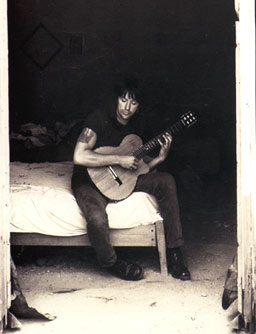
Kirk customized Richie's mahogany model Classical Electric with an intricate abalone vine inlay on the fretboard and cubic zirconium fretboard side dots (so he can see the frets when there is minimum lighting in a concert setting).
Since Richie's main ax is a Fender strat, Kirk was very flattered that he thought it played "like a nylon string strat."
Richard Smith
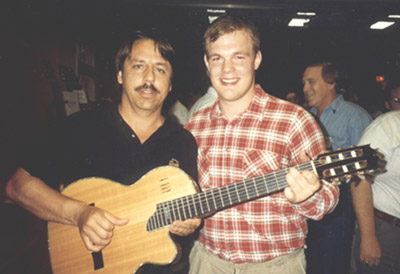 By the time Richard Smith was eleven years old, he could "play everything Chet could play just like Chet". Obviously a child prodigy, Richard impressed everyone who
laid ears on him (including Chet!), but he wasn't content with that kind of notoriety for long. Through his teenage years, faithful followers of Richard's virtuosity were
constantly delighted and amazed as this truly remarkable player evolved and grew.
By the time Richard Smith was eleven years old, he could "play everything Chet could play just like Chet". Obviously a child prodigy, Richard impressed everyone who
laid ears on him (including Chet!), but he wasn't content with that kind of notoriety for long. Through his teenage years, faithful followers of Richard's virtuosity were
constantly delighted and amazed as this truly remarkable player evolved and grew.
Richard has the chops to be one of the finest fingerstylists ever, but through the years he has also mastered every other style of music and incorporated the subtlest nuances of this exhaustive study into all of his playing. His gifted musicality, imagination, and flawless technique combine to make Richard Smith easily one of the great players of his time.
 The Smith family, comprised of Richard and his two also naturally talented brothers, Robert and Sam, and their VERY lovely and supportive parents, Doug and Ann, live in England. The Smith Brothers form a three-piece combo and travel throughout Europe and the United States performing and thrilling guitar fans wherever they go.
The Smith family, comprised of Richard and his two also naturally talented brothers, Robert and Sam, and their VERY lovely and supportive parents, Doug and Ann, live in England. The Smith Brothers form a three-piece combo and travel throughout Europe and the United States performing and thrilling guitar fans wherever they go.
Kirk met Richard in 1992 and built him a guitar "just like Chet's". They have recently collaborated on a new guitar, soon to be offered to all interested clients, called the Richard Smith Model. The guitar is in the current Year 2000 Batch and will be finished in June.
Tommy Emmanuel
So many people have written so eloquently about Tommy Emmanuel, the Australian fingerstyle virtuoso, that I thought I'd just let them tell you about him. (The other writers used up all the good adjectives anyway.) This is just a tiny selection of the volumes that have been written about this legend-in-the-making guitarist:
 Chet Atkins wrote in his book, Me and My Guitars,
"Tommy is about the only guitarist I've heard who can come close to what Lenny (Breau) did with harmonics, and he's got a style all his own. I think he's
probably the greatest finger-picker in the world today. He's inventive, fearless, and has a flawless sense of rhythm. He's a great showman, too. You can't
watch Tommy perform and not feel happy. I just love him. We made an album together in 1996 called The Day Finger Pickers Took Over the World
which I'm very proud of. It's got some beautiful tunes on it, and our playing blended well. Tommy is going to give the world a lot of great music in the coming years."
Chet Atkins wrote in his book, Me and My Guitars,
"Tommy is about the only guitarist I've heard who can come close to what Lenny (Breau) did with harmonics, and he's got a style all his own. I think he's
probably the greatest finger-picker in the world today. He's inventive, fearless, and has a flawless sense of rhythm. He's a great showman, too. You can't
watch Tommy perform and not feel happy. I just love him. We made an album together in 1996 called The Day Finger Pickers Took Over the World
which I'm very proud of. It's got some beautiful tunes on it, and our playing blended well. Tommy is going to give the world a lot of great music in the coming years."
"Tommy Emmanuel is a cross between Elvis and Paganini,” says his friend and frequent musical cohort, Stephen Bennet. Of the twenty great fingerstyle guitarists I have seen in concert, there is no rival for virtuosity and performance. He sells every note but has the chops to back it up. Tommy is constantly on tour so if you ever have a chance, go see him and you might walk away from his shows thinking about starting a small bonfire with your guitar collection. My wife says “after his show I felt completely drained, he covered every human emotion."
 In a review of Tommy's most recent release, Endless Road, Acoustic Guitar Magazine's own Jim Ohlschmidt describes
his range of styles as everything from "…a white-hot burst of thumb picking speed and skill, jaw-dropping by anyone's standards…" to something that "…lilts and slowly builds in gentle anticipation
like a sunrise." Jim also said that, "Emmanuel graces each phrase of the music with expressive nuance and dynamic emphasis that make all ten of his original pieces practically sing."
In a review of Tommy's most recent release, Endless Road, Acoustic Guitar Magazine's own Jim Ohlschmidt describes
his range of styles as everything from "…a white-hot burst of thumb picking speed and skill, jaw-dropping by anyone's standards…" to something that "…lilts and slowly builds in gentle anticipation
like a sunrise." Jim also said that, "Emmanuel graces each phrase of the music with expressive nuance and dynamic emphasis that make all ten of his original pieces practically sing."
I have to say that since meeting Tommy many years ago at the CAAS in Nashville , every good thing people say about him is true. We became friends and have admired each other's work for a long time. He has played in my booth and performed with my guitars, always telling me how much he loved playing them. It was such a pleasure for me to finally build a guitar for Tommy and finish it in July 2004. Watch for Tommy playing his new Sand Guitar on future recordings and appearances.
Steve Wariner
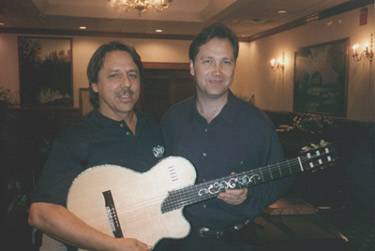

Steve Wariner, who is undoubtedly one of the most talented singer /songwriter /guitar pickers in Nashville today, first came to appreciate the Sand
Classical Electric guitar when Chet showed him his first one during a recording session.
Steve called Kirk to tell him how much he liked Chet’s guitar and eventually ordered one for himself.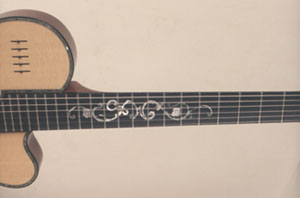
Two years ago, Kirk made a special guitar for Steve. It is a 2 ¼ inch deep mahogany model with abalone inlay. Steve designed a custom vine inlay on the fingerboard that cleverly spelled "S.W."
Personalized ideas like this are welcome from all our customers to make their instrument a true one-of-a-kind masterpiece.
Paul Yandell
 What can be said about the guy that has been sitting on Chet Atkins' right hand in every live performance for over thirty years?
Well, we could say that he earned this amazing privilege by being a flawless player, but that's to be expected. We could mention that Paul has that rare combination of
intuition and grace in his playing that is so necessary when backing up the Father of Fingerstyle, Mr. Guitar himself. But even that doesn't go far enough.
What can be said about the guy that has been sitting on Chet Atkins' right hand in every live performance for over thirty years?
Well, we could say that he earned this amazing privilege by being a flawless player, but that's to be expected. We could mention that Paul has that rare combination of
intuition and grace in his playing that is so necessary when backing up the Father of Fingerstyle, Mr. Guitar himself. But even that doesn't go far enough.
No, Paul Yandell is a great player in his own rite. If you take this shy, humble guy off the stage and somehow coax him into playing for you it will be immediately apparent that Paul is his own talent, that he plays with Chet because he loves the man and is devoted to the music.
Kirk built a guitar for Paul in 1996. Paul wanted a 2 ¼ inch deep mahogany model with a super slim neck. Soon after receiving his new Sand Guitar, Paul gave us this quote, "As close to perfection as you can get; a Sand guitar." Thank you, Paul. So are you.













